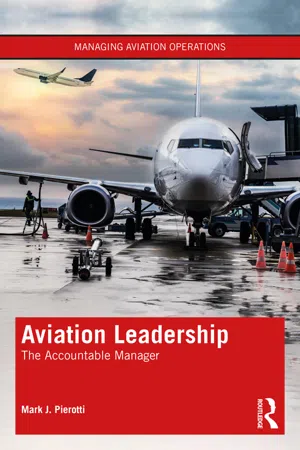
Aviation Leadership
The Accountable Manager
Mark J. Pierotti
- 174 Seiten
- English
- ePUB (handyfreundlich)
- Über iOS und Android verfügbar
Aviation Leadership
The Accountable Manager
Mark J. Pierotti
Über dieses Buch
This book identifies the responsibilities of management in the regulatory territories of the FAA (USA), the EASA (European Union) and the GCAA (UAE), identifying the daily challenges of leadership in ensuring their company is meeting the regulatory obligations of compliance, safety and security that will satisfy the regulator while also meeting the fiducial responsibilities of running an economically viable and efficient lean company that will satisfy the shareholders.
Detailing each responsibility of the Accountable Manager, the author breaks them down to understandable and achievable elements where methods, systems and techniques can be applied to ensure the role holder is knowledgeable of accountabilities and is confident that they are not only compliant with the civil aviation regulations but also running an efficient and effective operation. This includes the defining of an Accountable Manager "tool kit" as well as possible software "dashboards" that focus the Accountable Manager on the important analytics, such as the information and data available, as well as making the maximum use of their expert post holder team.
This book will be of interest to leadership of all aviation- related companies, such as airlines, charter operators, private and executive operators, flying schools, aircraft and component maintenance facilities, aircraft manufacturers, engine manufacturers, component manufacturers, regulators, legal companies, leasing companies, banks and finance houses, departments of transport, etc; any relevant organisation regulated and licensed by civil aviation authority. It can also be used by students within a wide range of aviation courses at colleges, universities and training academies.
Häufig gestellte Fragen
Information
1An introduction to civil aviation, the regulations and air law
The Chicago Convention and the International Civil Aviation Organization
… any specification for physical characteristics, configuration, material, performance, personnel, or procedures, the uniform application of which is recognized as necessary for the safety or regularity of international air navigation and to which member states will conform.Standards may thus include specifications for such matters as the length of runways, the materials to be used in aircraft construction and the qualifications to be required of a pilot flying an international route. A recommendation is any such specification, the uniform application of which is recognised asdesirable in the interest of safety, regularity, or efficiency of international air navigation and to which member states will endeavour to conform.(The Chicago Conference, 1944)
… the undersigned governments having agreed on certain principles and arrangements in order that international civil aviation may be developed in a safe and orderly manner and that international air transport services may be established on the basis of equality of opportunity and operated soundly and Economical.(The Chicago Conference, 1944)
The Articles, Annexes and Standards and Recommended Procedures of the Chicago Convention
Inhaltsverzeichnis
- Cover
- Half-Title Page
- Series Page
- Title Page
- Copyright Page
- Dedication
- Contents
- List of figures
- List of tables
- About the author
- Acknowledgements
- Introduction
- 1 An introduction to civil aviation, the regulations and air law
- 2 An introduction to the Accountable Manager
- 3 Leadership of the Post Holders
- 4 Organisational structures in a civil aviation company
- 5 Ethical leadership and the Accountable Manager
- 6 A tool kit and SOPs for the Accountable Manager
- 7 How to select an effective Accountable Manager
- 8 Female Accountable Managers and the added challenges
- 9 A lawyer’s review of the Accountable Manager’s responsibilities
- 10 Case studies of Accountable Manager challenges
- Summary
- Glossary
- Index